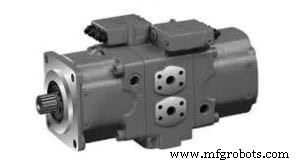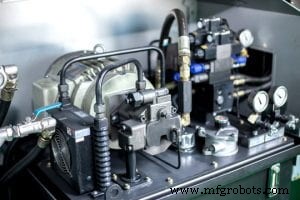Was bestimmt die Drehzahl eines Hydraulikmotors
Wenn Sie etwas mit einem Hydraulikmotor bewegen möchten, müssen Sie zwei Dinge wissen:die Geschwindigkeit der Flüssigkeit (in Metern pro Sekunde) und die Geschwindigkeit des Motors (in Metern pro Sekunde). In diesem Artikel konzentrieren wir uns auf die Motordrehzahl und sehen, wie sie die Geschwindigkeit der Flüssigkeit beeinflusst.
Elektromotor
Elektromotoren arbeiten nach dem Prinzip der elektromagnetischen Induktion. Ein rotierender Elektromotor besteht aus mehreren Elektromagneten, einem für jeden Pol. Wenn ein elektrischer Strom durch die Elektromagnete fließt, werden sie magnetisiert und drehen sich gegeneinander um ihre eigene Achse. Dies erzeugt eine Rotationskraft, die genutzt werden kann, um einen Elektromotor anzutreiben. Die Drehzahl eines Motors wird durch die Strombelastbarkeit und die Größe der Elektromagnete bestimmt.

Hydraulikmotor
Ölpumpe oder Öltaumelscheibe
Es wird viel darüber diskutiert, was die Drehzahl eines Hydraulikmotors bestimmt. Manche Leute sagen, dass die Ölpumpe die Drehzahl bestimmt, während andere sagen, dass die Ölspritzplatte dies tut. Beide Theorien haben einige Beweise, die sie stützen, aber keine ist definitiv richtig.
Die Ölpumpentheorie basiert auf der Tatsache, dass eine höhere Drehzahl einen höheren Ölfluss durch die Pumpe erfordert. Dies wiederum bedeutet, dass die Pumpe härter arbeitet und der Motor daher schneller läuft.
Es gibt jedoch mehrere andere Faktoren, die die Drehzahl eines Hydraulikmotors ebenfalls beeinflussen können. Wenn sich beispielsweise Schmutz in den Ölleitungen befindet oder die Motoren beschädigt sind, können sie nicht so effizient arbeiten und werden dadurch langsamer. Außerdem kann die Temperatur auch beeinflussen, wie schnell ein Motor läuft – je kälter es ist, desto langsamer wird er.
Letztendlich ist es unmöglich, genau zu bestimmen, wie schnell ein Hydraulikmotor läuft, ohne ihn persönlich zu untersuchen. Wenn Sie jedoch verstehen, wie verschiedene Faktoren seine Geschwindigkeit beeinflussen können, können Sie sicherstellen, dass er mit der bestmöglichen Leistung arbeitet.
Die Drehzahl eines Hydraulikmotors
Ein Hydraulikmotor ist typischerweise schneller als ein Elektromotor, da sich die Hydraulikflüssigkeit schneller bewegen kann. Außerdem muss sich ein Hydraulikmotor nicht so oft drehen, um das gleiche Ergebnis wie ein Elektromotor zu erzielen.
Ein Hydraulikmotor kann jedoch auch weniger leistungsstark sein als ein Elektromotor. Dies liegt daran, dass ein Hydraulikmotor nicht die gleiche Leistung wie ein Elektromotor hat, um ein Drehmoment zu erzeugen.
Ein Hydraulikmotor arbeitet, indem er unter Druck stehendes Fluid verwendet, um eine Welle zu drehen. Diese Welle kann dann verwendet werden, um ein Objekt zu bewegen oder Aufgaben auszuführen.
Das Druckfluid kann aus einem Vorratsbehälter kommen oder vom Motor zugeführt werden. Das Reservoir ist typischerweise mit Öl, Wasser oder einer anderen Art von Flüssigkeit gefüllt.
When the hydraulic motor is powered, the pressurized fluid is forced into the engine. This causes the engine to turn and create torque. The torque causes the shaft to rotate and move the object or perform the task.
Compression of the Oil
A hydraulic motor’s speed is determined by how much compression the oil can withstand before it ruptures. The higher the compression, the faster the motor will operate.
Oil compression is measured in psi (pounds per square inch). The higher the psi, the more pressure the oil can withstand before it ruptures.
The maximum oil compression that a hydraulic motor can withstand is around 3000 psi.
If the oil reaches a certain psi level, it can rupture. This can happen suddenly, causing the motor to stop abruptly. Or it can happen over time, with the oil gradually breaking down and becoming unable to withstand the pressure.
Either way, rupture of the oil can be dangerous and lead to a loss of engine power. So it’s important to keep an eye on your oil pressure and make sure it stays within safe limits.
The Output Torque of the Motor
When you buy a motor, it’s important to know the output torque. Output torque is what allows the motor to do its job, and it’s measured in inch-pounds. The higher the output torque, the faster the motor can move objects.
There are a few things that affect output torque. One is the size of the motor. Larger motors have more output torque than smaller motors. Another factor is how quickly the motor can turn. A fast motor has more output torque than a slow motor.
The final factor that affects output torque is the type of fluid inside the motor. Fluids with low viscosity (a thick liquid) have more output torque than fluids with high viscosity (a thin liquid). This is because a low viscosity fluid can flow through a smaller diameter pipe faster than a high viscosity fluid can.
hydraulic motor displacement
A hydraulic motor can be thought of as a piston in a cylinder. The piston is connected to a rotating shaft, and the cylinder is filled with pressurized fluid. The pressure in the cylinder drives the piston, which in turn rotates the shaft.
The size of the piston determines how fast the motor will spin. A small piston will move around quickly, while a large piston will move more slowly. The speed of the motor also depends on how much fluid is inside the cylinder and how tightly the piston is connected to the shaft.
pressure of the oil in the system
The speed of a hydraulic motor is determined by the pressure of the oil in the system. The higher the pressure, the faster the motor will run.
The amount of pressure needed to run a hydraulic motor depends on the type of motor and the size of the system. Typical pressures for various types of motors can be found on the manufacturer’s website. For systems up to 10,000 lb (4,500 kg), a pressure of 40 psi (275 kPa) is typically used. Systems larger than 10,000 lb (4,500 kg) may require higher pressures, such as 50 psi (340 kPa).
esistance to the load being moved
hydraulic motors are typically rated by the number of pounds of pressure that their cylinders can produce. The higher the pressure, the faster the motor will move the load. However, there are other factors that also play a role in how quickly a motor moves a load, such as shaft size and design, number of gears, and motor construction materials.

hydraulic motor
Schlussfolgerung
In this article, we will explore the different factors that determine the speed of a hydraulic motor. We will start by looking at the flow rate and pressure drop in a hydraulic system. We will then look at the power input and output of a hydraulic motor, and finally discuss how these factors affect the speed of a hydraulic motor. Hopefully, this article has helped you better understand how to calculate the speed of a hydraulic motor.
Industrielle Ausrüstung
- Motorwicklungen:Was sind die Unterschiede?
- Gleichstrom- und Wechselstrommotor:Was ist der Unterschied?
- Was ist die Farbenindustrie?
- Was ist hydraulischer Kalk?
- Was ist ein hydraulisches Hebezeug?
- Welche Art von Hydraulikmotor ist am effizientesten?
- Wie steuert man die Drehzahl eines Hydraulikmotors?
- Was bestimmt die Drehzahl eines Hydraulikmotors?
- Was sind die 2 Klassifikationen von Hydraulikpumpen?
- Was ist die effizienteste Hydraulikpumpe?



